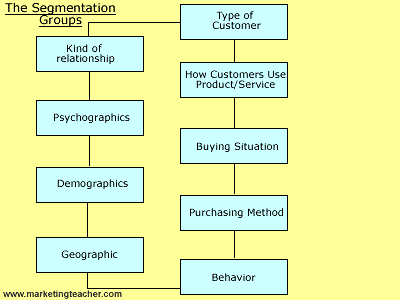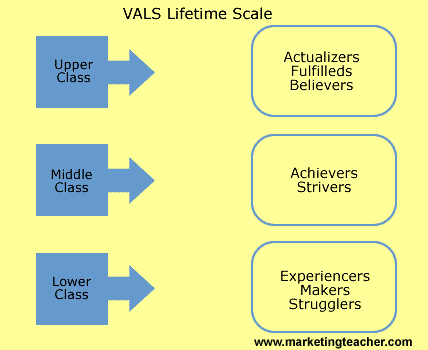Segmentation, Demographics and Behavior
- Relationship
- Customer Type
- Product Use
- Buying Situation
- Purchasing Method
- Behavior
- Geographic Location
- Demographics
- Psychographics
Relationship
- Kind of relationship— weak, strong, “arm’s length” dealing, close partnership.
Customer Type
- Type of customer— manufacturer, service, government, military, non profit, wholesaler, retailer, end user.

Product Use
- How customer’s use product— installation, components, accessories, raw material, eaten, professional service.
Buying Situation
- Buying situation— rebuy, modified rebuy, new purchase.
Purchasing Method
- Purchasing methods— Internet, long term contract, warranty, financing, cash on demand.
Behavior
- Needs—economic, functional, psychological, social.
- Benefits--quality, service, economy, convenience, speed.
- Attitude toward product--Enthusiastic, positive, indifferent, negative, hostile.
- User status--Nonuser, ex user, potential user, first time user, regular user.
- Loyalty status--None, medium, strong, absolute.
- Brand Familiarity-Unaware, aware, informed, interested, desirous, intending to buy.
- Occasion--Regular occasion; special occasion, convenience, comparison shopping, unsought product.
- Type of problem solving needed-routine, limited, extensive.
- Information required-low, medium, high.
Geographic Location
- Region of world, country— North America, South America, Africa, Asia, Europe.
- Regions within that country— (For Example USA) Pacific Northwest, South, Midwest, New England.
- Size of city— population under 5,000 people to 4 million or more.
- Urban vs. rural— country, city, large city = more resources, more independence; country=more dependence on neighbors and pooling resources.
- Climate— cold, hot, rainy, desert, beaches, mountains.
Demographics
- Income— under $5,000 to $250,000+ a year.
- Gender— male, female, neither, both.
- Age— Infant, toddler, preschool, tween (age 8 to 12), teen, college age, 20, 30, 40, 50, 60, 70-90.
- Family size— 1 person, 2, 3, 4, 5 or more.
- Family life cycle— young, single, engaged, DINKS (double income no kids), SINKS (single income no kids), married with kids (babies, toddler, elementary school age, teen, older), recently divorced, empty nester (children have moved out), same-sex couples, single parents, extended parents (grandparents raising their grandchildren), retired (either wealthy or Medicare dependent/poor). There are also Boomerang Kids (adult children have moved back home), Cougar/Silver Fox (Cougar is a 40-60 year old weathly, single, career driven woman seeking a younger man; Silver Fox is a 40-60 year old wealthy, single, career driven man seeking a younger woman).
- Job— unemployed, housewife, part-time, full-time, student, professional, craftsperson, farmer, retired.
- Education— grade school or less, some high school, high school graduate, some college, college graduate, graduate degrees.
- Religion— Christian, Jewish, agnostic, atheist, Muslim, Islam etc.
- Race— White, Black, Asian, Hispanic, Native American, mixed race, etc.
- Culture/nationality—American, French, English, African, Russian, Indian etc.
- Generation— (For Example USA) GI Generation, Silent, Matures, Baby Boomer, Gen X, Gen Y, Boomlets.
Psychographics
- Lifestyle— interests, hobbies, activities, interests, opinions, values, media preferences. Everyone has two lifestyles, the one they are in now, and the one they desire to be in, which is usually better than the current one. Almost all decisions are influenced by the buyer’s current and desired lifestyle.
- Personality traits
- Sincerity.
- Excitement.
- Competence.
- Sophistication.
- Ruggedness.
- Social class— Lower, middle-low, middle, middle-upper, upper, upper-upper, working class, blue collar.


No comments:
Post a Comment